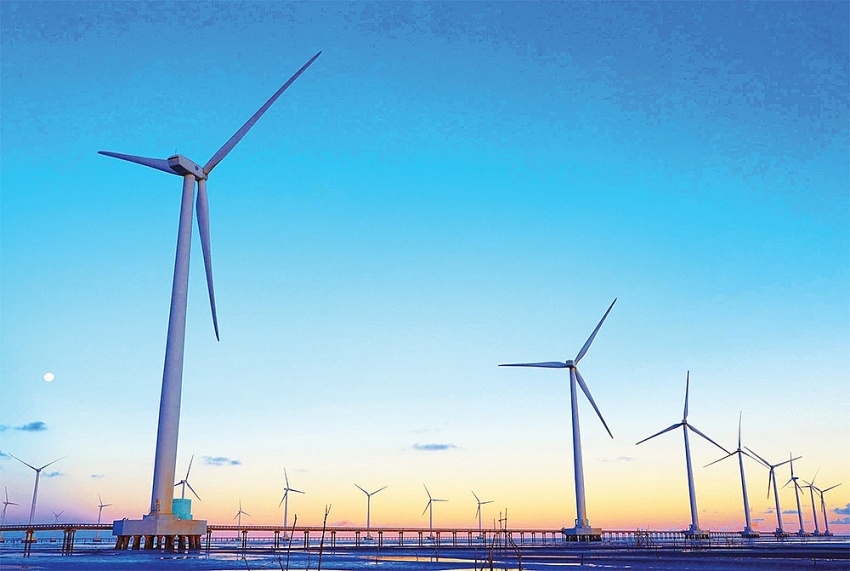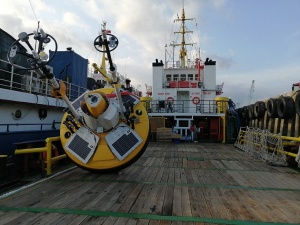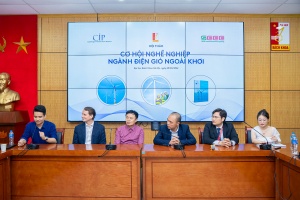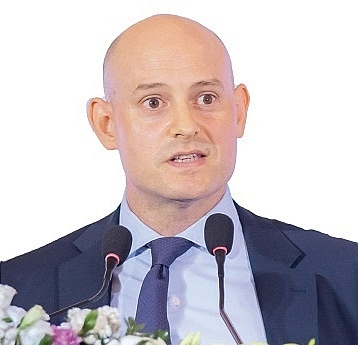Measures for offshore wind must be carried out rapidly
 |
| There are currently complex investment processes, leading to long preparation time and potential implementation risks |
Last week at a workshop in Hanoi, Mark Hutchinson, director and chair of the Southeast Asia Taskforce at the Global Wind Energy Council (GWEC), said that Vietnam had only developed intertidal wind projects near the coast, and no real offshore wind (OSW) ventures had been started.
According to Hutchinson, an OSW scheme takes 6-8 years to set up, and thus the first potential pilot project may not be ready until 2032.
“Under the first draft pilot mechanism for OSW regulations, the GWEC and our members encouraged collaboration with experienced developers. The industry supports the move to competitive procurement for several reasons, mainly because of its transparency. A transparent, competitive procurement process will push OSW forward in Vietnam,” Hutchinson said.
The key suggestions to speed up progress mentioned at the workshop included implementing a simple remuneration mechanism for initial pilots, developing a streamlined permitting process, a robust marine spatial planning and site allocation approach, defining a clear auction timeline, and enhancing power purchase agreement bankability to engage international finance.
Bui Van Thinh, chairman of Binh Thuan Wind and Solar Power Association, said, “There is a lack of regulations, policies, spatial planning, and price policies for electricity. Electricity is increasingly lacking, but electricity projects cannot be implemented. Investors can generate electricity, but are concerned about prices.”
The cost of wind power production has decreased sharply, from about 25 US cents per kWh more than 10 years ago to about 10 US cents per kWh today, and it may decrease to 6 US cents per kWh in the future.
Nguyen Hoang Anh of Vietnam Electricity (EVN) said that building a power transmission system for OSW initiatives was difficult due to electricity regulations, and the national marine spatial master plan for this decade has not been approved.
“There is no planning for underground cable routes connecting such power projects. There are complex investment processes, leading to long preparation times and potential risks during implementation, and lack of regulations on investment in OSW projects in general. There is no clear and transparent mechanism for power prices or principles to regulate the field,” he said.
Meanwhile, an energy outlook report released by EVN and its Renewable Energy Authority, in conjunction with the Danish Energy Agency and the Danish Embassy, noted that in the net-zero scenario, OSW capacity will expand to 84GW by 2050.
Crafting the necessary framework to roll out the planned pilot schemes for OSW is therefore a prerequisite to achieve the targets stated in Power Development Plan VIII (PDP8) and beyond, considering the long planning and construction time needed, it said.
“This includes implementing adequate regulations and guidelines including marine spatial planning, a price framework, and a clear permitting process to ensure speed of implementation,” said Rasmus Munch Sørensen, advisor for the Danish Energy Partnership Programme for 2021-2025. “At the same time, it is important to conduct an analysis of grid point connections, build needed seaport infrastructure, and ensure a skilled workforce.”
Pilot projects, as outlined under the PDP8, should be progressed as soon as possible to build the necessary experience, mitigate and minimise risks and costs, and increase confidence for investors, Sørensen added.
Marine spatial planning proposals are expected to be submitted to the National Assembly before the end of June. Previously, in April, the Ministry of Industry and Trade submitted a draft proposal for the pilot mechanism of related projects, which involves an energy steering committee that was established in November 2023 to oversee related ventures.
The Asia-Pacific region is expected to add 215GW of offshore wind power generation capacity between now and 2033, and China will be responsible for three-quarters of the figure, according to the latest estimates by GWEC.
Based on the GWEC Market Intelligence data released in June, Taiwan will account for 7 per cent of the new installations, and South Korea for 5 per cent. Japan, Vietnam, and India will be responsible for 3 per cent.
| Juan Frías, head, Offshore Wind Auctions and Cost Engineering, OWC
A two-stage model is proposed for Vietnam to consider a review of the legal framework. In a one-stage competition model, exclusivity over survey rights and the offtake are awarded simultaneously. This fixes the electricity tariff at a very early stage in the development process. In Vietnam, as in other early-stage markets, there are major uncertainties around development timelines, supply chain availability, financing conditions, and costs. These pose major risks to the business cases of investors. In a competitive selection process, these issues could lead to very high-risk or delayed projects. Both situations would diminish public and political support for OSW and erode the confidence of financiers. The key objectives of the competitive selection model proposed for Vietnam will ensure the most transparent, reasonable, and comparable auction criteria, and give confidence to investors on future opportunities. However, there is no one-size-fits-all tendering scheme for related projects, as competitive selection processes are market-specific. Denzel Eades, managing director Pioneer International Consulting
The Vietnamese government needs to focus on quickly promoting OSW power policies, as the regulatory framework in Vietnam remains underdeveloped. The goal to have the first projects put into commercial operation by 2030 is becoming more and more difficult. The process of developing legal regulations and legal frameworks takes a long time, on average 2-3 years, and a new law may need to be promulgated. In addition, because many related regulations overlap between different ministries and government agencies, close coordination between relevant agencies is extremely important. With current common challenges, achieving the 2030 targets will require great effort and quick actions from the government. In Vietnam, the investor selection process applicable to OSW has also not been clarified. Competitive tendering for large-scale power projects has been unsuccessful, and those subject to bidding require a state-issued pre-feasibility study and state-assisted land clearance. Specific requirements for the selection of investors have not been determined and the authorities responsible for investor selection are subject to review. |
 | Dutch firm extends partnership with PTSC G&S to support Vietnam's offshore wind sector Dutch offshore survey firm Fugro announced on March that it has extended its MoU with Vietnam's PTSC Geos & Subsea Services Co., Ltd (PTSC G&S) to meet Vietnam’s strong demand for geophysical, geotechnical and metocean data services. |
 | Offshore wind industry creating thousands of high-quality jobs in Vietnam Vietnam plans to increase its offshore wind power capacity from zero in 2023 to 6GW by 2030, with a target of 70-91.5GW of offshore wind power by 2050. To achieve this goal, investors, developers, and contractors need to prepare a skilled and high-quality workforce, especially for large-scale offshore wind projects. |
What the stars mean:
★ Poor ★ ★ Promising ★★★ Good ★★★★ Very good ★★★★★ Exceptional
Related Contents
Latest News
More News
- Heavy industries set for pilot greenhouse gas quotas (December 25, 2025 | 10:00)
- Swedfund invests in MSME growth and climate action in Vietnam (December 19, 2025 | 11:42)
- GreenYellow brings solar energy to light up remote schools in Tuyen Quang province (December 19, 2025 | 08:00)
- Charge+, Grab partner to develop EV charging network in Vietnam (December 18, 2025 | 17:11)
- Linking sci-tech and innovation to Vietnam’s net-zero future (December 18, 2025 | 14:31)
- Driving double-digit growth through green and circular transformation in Vietnam (December 17, 2025 | 09:00)
- Standard Chartered and ACCA deepen collaboration to develop Vietnam’s talent for a sustainable future (December 15, 2025 | 18:18)
- Schaeffler reports strong early output from Dong Nai solar project (December 12, 2025 | 15:16)
- Forestry conference highlights biodiversity and sustainability goals (December 09, 2025 | 13:35)
- Home Credit honoured among top 10 sustainable companies in trade and services (December 09, 2025 | 12:18)



 Tag:
Tag:




















 Mobile Version
Mobile Version